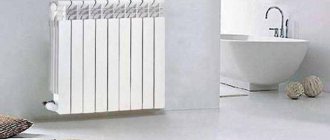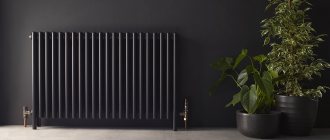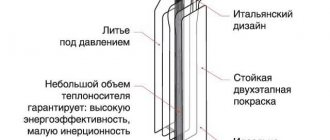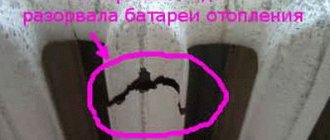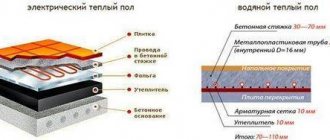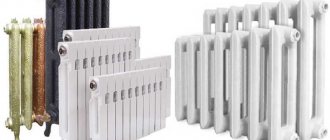It is a mistake to believe that choosing a heating radiator does not raise questions and it is enough to select the appropriate number of sections and the optimal connection option. Modern technology has burst into this sector, offering an impressive range and variety of designs. The combination of two metals and a progressive approach to design have increased the efficiency of the most important element of the heating system. And a competent design will allow you not to hide it, but to turn it into part of the design. To make a successful purchase and take a really good model, our editors have compiled a rating of the best bimetallic radiators from popular manufacturers.
Bimetallic radiator: device and types
The new generation heating device is made of aluminum and steel. The most important thing about it is its internal structure.
Radiators are divided into two types:
- Full bimetallic, consisting of vertical tubes and horizontal steel collectors. The connected parts are die-cast aluminum. The advantage of this device is that the coolants are located so that you cannot get burned on them. Radiators can withstand high temperatures (up to 130 degrees) and pressure from 35 atmospheres. The number of elements can be removed or added from the battery.
- Partially bimetallic, having only a steel vertical channel that conducts water. Such batteries are not protected from rust, but they do not have excess pressure. Such models are most often found on the Russian market.
Some manufacturers offer bimetallic radiators made of copper and aluminum. These are universal models, but the price for bimetallic heating radiators of this type is much higher.
The aluminum body has a built-in copper coil that can withstand 40 atmospheres of pressure. The advantage of such a battery is that copper conducts heat well and does not rust.
Bimetallic batteries - which ones are better: compare their characteristics with aluminum ones
Bimetallic radiators, which, as the name suggests, are made from a composition of two metals, began to be produced more than fifty years ago in European countries. They quickly gained wide popularity due to their reliability and operational efficiency when installed in any heating system.
Which bimetallic batteries are better?
Which bimetallic batteries are best to choose, and what should you pay special attention to? This question always arises for all those who have decided to replace old heating devices with more modern options, characterized by both high performance characteristics and a respectable appearance.
Today, the production of bimetallic radiators has also been established in Russia. Domestic products are quite popular and have fully justified themselves when installed in central heating systems.
Design of bimetallic radiators
General design principles
This type of radiator consists of two main parts made of different metals.
Internal channels are made of stainless steel, external heat exchange housing is made of aluminum
Their internal part is made of stainless steel or, less commonly, copper, since these metals are highly resistant to the aggressive environment of a heated coolant. Pipes made of these materials are arranged vertically and horizontally, and it is through them that the coolant circulates.
The outer part of the radiators is, in fact, a casing equipped with fins, which is made of aluminum. This metal has excellent thermal conductivity and quickly warms up, releasing heat into the premises, which is why it was chosen for the external part of the structure.
Bimetallic radiator in section
The internal and external parts of each radiator section are connected to each other by injection molding or spot welding. The sections are assembled into a battery using steel nipples and heat-resistant rubber gaskets designed for temperatures reaching up to 200 degrees. However, in addition to such batteries, there are also monolithic radiators made of the same materials.
The crimping rating pressure of bimetallic batteries may vary from one manufacturer to another - this indicator depends on the material of the internal pipelines and dimensional parameters. If, when testing certain models, a test pressure of 35 atmospheres was created, then they will be able to withstand water hammer, pressure drops during which reach 25 ÷ 30. This allows the use of such radiators in central heating systems, which sometimes do not have stable coolant pressure.
Due to their high thermal conductivity, bimetallic devices turned out to be even more efficient than the familiar cast-iron batteries.
In appearance, bimetallic radiators are practically no different from aluminum models. However, they can be distinguished by weight, since due to the steel pipe “core”, bimetallic batteries are heavier than aluminum ones, by about 50%. In order not to make a mistake when choosing, you should definitely study the certificate of conformity and other accompanying technical documentation, which must be attached to the product batches and is available from the seller of a specialized store.
Bimetallic and semi-bimetallic radiators
In addition to bimetallic ones, semi-bimetallic radiators are also produced. You need to know how they differ from each other and which ones are better.
- Bimetallic devices
In real bimetallic radiators, only the outer casing of the device is made of aluminum.
Their production process consists in the fact that ready-made all-steel cores, placed in special molds, are filled under pressure with aluminum, which conducts heat well, but is not resistant to aggressive environments and high coolant temperatures. In bimetallic versions, aluminum does not come into contact with the liquid medium and serves only as a heat exchanger. A design made according to this principle is ideal for installation in both central and autonomous heating systems.
In some models, the core is made of copper rather than stainless steel - such batteries are usually used for installation only in an autonomous heating system, where special antifreeze is used as a coolant. Steel pipes, even stainless ones, do not “behave” so adequately with some similar antifreezes.
Water is not the only possible type of coolant
To dust the circuits of an autonomous heating system, in addition to water, other liquids are used - this may be due to the operating characteristics of the system or the requirements of the boiler equipment. Read more about coolants for heating systems in a special publication on our portal.
- Semi-bimetallic batteries
For semi-bimetallic radiators, the internal channels are made of different metals. Thus, vertical pipes can be stainless steel, and horizontal pipes can be aluminum, as in conventional aluminum radiators. The opposite also happens. In a word, they are in no way suitable for full-fledged bimetallic ones.
Be careful - instead of full-fledged bimetallic ones, there is a chance to purchase lower-quality and reliable semi-bimetallic radiators
This type of battery is not suitable for central heating, since the coolant there is often not of high quality and it is fashionable to contain a fairly high concentration of alkali. When in contact with aluminum, such a composition can cause corrosive processes, which will also “capture” steel elements installed in combination with aluminum. In addition, the different thermal expansion of these metals can even cause elements to shift when exposed to extremely high temperatures, which can lead to leaks and even more serious accidents.
Such radiators are often confused with bimetallic ones - outwardly they are generally indistinguishable. Without particularly understanding the intricacies, they are often preferred due to their more affordable cost. However, as can be seen from the description, they differ quite significantly in their reliability.
As a last resort, a semi-bimetallic type of radiator can be installed in an autonomous system. But still, if you decide to make the heating of your house or apartment as reliable as possible, then it is better to abandon semi-bimetallic radiators and opt for real bimetallic samples. Be sure to take this into account when purchasing.
Monolithic or sectional bimetallic radiators
As already noted, collapsible bimetallic radiators are produced, which consist of sections fastened together with nipples, and monolithic non-dismountable ones.
In the sectional version, each section inside the horizontal pipe sections on both sides has multidirectional threads designed for screwing in connecting nipples with sealing gaskets.
Bimetallic battery of sectional, collapsible type
This design is the main significant drawback of sectional batteries, since these joints can be damaged by, for example, low-quality coolant, which significantly reduces their service life until the next preventive intervention. In addition, leaks most often occur at the connections of elements under the influence of high temperatures and high pressure in the system.
To avoid these unpleasant moments, another technology for the production of bimetallic radiators was thought out. It consists in the fact that first a solid welded copper or steel manifold is made, which is placed in a special mold and filled with aluminum under pressure. These bimetallic batteries are called monolithic.
And this bimetallic radiator is a monolithic assembly
Both types have their own advantages and “vulnerabilities”.
The disadvantage of the collapsible circuit has already been mentioned. And the main advantage of such batteries is that if one of the sections is damaged, you will not have to replace the entire radiator, since it is quite enough to reassemble it - replace or simply remove only the failed element.
In the event of any leakage in a monolithic radiator, all that remains is to replace it completely - they have practically no maintainability.
Selected comparative characteristics of both types of radiators are shown in the table:
| Operating Parameters | Sectional bimetallic radiators | Monolithic bimetallic radiators |
| Service life, years | 25÷30 | up to 50 |
| Working pressure, bar | 20÷25 | up to 100 |
| Thermal power, per section, Watt | 100÷200 | 100÷200 |
Cost is often the deciding factor. The fact is that the monolithic type of radiators has a higher price than the sectional one, and this difference can be up to 20%.
When using monolithic bimetallic batteries, it is not possible to vary the total thermal power - to reduce or increase the number of sections. Therefore, before purchasing them, it is necessary to carefully calculate how much power is needed to heat a particular room. Selecting the right option will not be difficult, since monolithic bimetallic radiators are produced in different sizes, both in length and height.
When choosing between sectional and monolithic batteries, you should also take into account the features of the heating system. For example, if you plan to install them in an apartment in a high-rise building, then it is better to choose a monolithic type of device, since the pressure in the heating system of high-rise buildings is often quite high, and water hammer cannot be ruled out. and the connecting nodes of sectional batteries may not withstand it and leak.
Criteria for choosing bimetallic radiators
When choosing a specific model, in addition to the characteristics already mentioned above, there are other points that will directly affect the quality of operation of heat exchange devices and the duration of their operation.
- The radiator design must withstand water hammer and high pressure. This is especially important to consider when installing them in a central heating system. Be sure to pay attention to the test pressure indicator.
- The battery material must be inert to the aggressive environment of low-quality coolant with a high level of alkali or acidity. This factor also mainly concerns batteries installed in multi-storey buildings.
- The manufacturing material must also resist electrochemical corrosion.
A sad result of mechanical impact on a low-quality radiator
- Radiators must be resistant to mechanical stress, that is, their outer casing must have sufficient strength. To check the quality of the aluminum (aluminum alloy) used, you need to try to bend the rib with your fingers. In a low-quality product, the ribs bend easily, and sometimes they can even crack or break.
Even in the thinnest place, heat transfer fins should not bend and, especially, break
- The internal ribbed channels must be made of one metal, and it is better if it is high-quality stainless steel.
- The wall thickness of the inner pipe must be at least 3÷3.5 mm.
- An important element in the sectional design of a battery is the gaskets, since the reliability of the connections will depend on their quality and elasticity, so most often they are made of rubber or silicone. You can check the quality of the O-ring by bending it several times with your fingers. If the gasket is hard and inelastic, then it will clearly not last long.
Particular attention to the quality of the nipples - they must be made of durable steel
- The sectional radiator must be equipped with high-quality steel nipples, in which the internal “antennae” will not break off when twisting the sections and the threads will not be “gobbled up”. You can tell that the nipple is of poor quality by the softness of the metal it is made of.
Poor-quality nipples and seals can bring a lot of trouble.
If this element is of poor quality, then when unscrewing or twisting the battery, the hooks for the key will definitely break off, and then the nipple will have to be sawed with a grinder, and then its parts removed from the holes of the sections.
- The width of the front part of the radiator fin should not be less than 70 mm, since if this parameter is smaller, the heat transfer from the device is significantly reduced. It is best if the cross-sectional size of the section is 80×80 mm - such parameters are guaranteed to provide high heat transfer.
The optimal depth and width of the sections is about 80 mm.
Some manufacturers use a marketing ploy - they reduce the price of their products by reducing the size of the sections, which significantly reduces the overall thermal power of the device. Therefore, when choosing a radiator, it is advisable to have a tape measure or ruler in your pocket so that you can check the optimal dimensions.
- For a high-quality battery, the thickness of the protruding ribs should be at least 1 mm.
A good radiator has fins with a thickness of about 1 mm
. If the thickness of the fins is less than 1 mm, then this most likely indicates insufficient quality of the product, since it has reduced strength of the radiator casing, and also the heat transfer is not so high - due to the low heat capacity of too thin heat exchange plates.
But on this model the thickness of the ribs is clearly underestimated - it’s worth thinking about...
- You also need to know that if a manufacturer skimps on high-quality nipples and gaskets, this means that the entire product, with a probability close to 100%, is not of high quality, and it is better to discard it immediately.
- You should not buy devices for which the manufacturer provides a warranty period of only 1–2 years, despite the fact that the service life of bimetallic sectional batteries is 25-30 years, and monolithic ones – even about 50. Such a small guarantee indicates that the manufacturer himself is not confident in his products.
Advantages and disadvantages of bimetallic radiators
Next, it would be nice to highlight the main “pros” and “cons” of these fairly popular devices today.
positive qualities include the following:
- Bimetallic radiators fit perfectly into modern interiors of both residential and office premises.
Bimetallic radiators fit very well into the modern interior of residential premises
- This type of radiator is often available in different colors. If the desired color is not found, then self-coloring is allowed. For this process, special heat-resistant paint compositions are used that can withstand temperatures up to 150 degrees.
- Smooth surfaces and rounded corners make these radiators quite safe from the point of view of the possibility of injury, and therefore suitable for installation in children's rooms.
- The advantage is a fairly long guaranteed service life, provided that high-quality radiators are selected and used correctly.
- Bimetallic radiators can be installed in any heating system, even with low-quality coolant.
- This type of device, unlike other modern radiators, is capable of withstanding high intra-system pressure and temperatures of up to 130 degrees.
- One of the key advantages of such batteries is very high heat dissipation.
- Such devices are usually equipped with a thermostat, which allows you to set the desired heating temperature. Its correction occurs almost immediately, due to the small cross-section of the channels.
- The number of radiator sections for each specific room can be easily calculated independently using the mathematical formula given below. Correct calculation will help to avoid unnecessary costs when purchasing radiators, their installation and further operation.
Find out everything about the thermostat for a heating battery from our new article on our portal.
These devices also have their own disadvantages , which you should be aware of, since they can also affect the informed choice of radiators.
- As mentioned above, bimetallic batteries can be installed in any, including central heating system. But you need to take into account that low-quality coolant can still significantly reduce their service life. However, they show all their advantages precisely at high-temperature operating conditions.
- An important disadvantage of these combined devices is the different expansion coefficients of steel and aluminum. Therefore, after long-term use in the heating circuit, noise sometimes occurs - creaks, a gradual decrease in structural strength and even thermal power is possible - direct heat transfer between the two metals is disrupted.
- When installing radiators in a central heating system, the heat-conducting pipes may quickly become clogged, since they have a small diameter. To avoid this, it is advisable to install a coarse filter.
- The high cost of bimetallic devices can also be considered a negative aspect when purchasing them, since it exceeds the prices of batteries made of aluminum, steel and cast iron. However, given the quality and durability of such products, such costs are completely justified.
Calculation of the number of sections of bimetallic radiators
It is quite simple to approximately calculate the required number of sections for heating a specific area. A simple formula is used for this. To make such a calculation, you will need parameters such as the power of one section (indicated in the product passport or in the store price list) and the area of the room.
The number of sections of the bimetallic battery must correspond to the characteristics of the heated room
It is generally accepted that 100 W of thermal energy is required to effectively heat one square meter of area.
The area of a standard room is calculated by multiplying the width of the room by its length.
Complex cases of calculating room areas
The non-standard configuration of the rooms sometimes confuses the owners, who have somewhat forgotten their school geometry course. How to determine the area of a room - read in a special publication on our portal. It also contains convenient calculators that make the calculation process easier.
So, to approximately determine the number of sections, take the following formula:
N = S × 100 / P
N – number of radiator sections;
S – room area, m²;
P – specific thermal power of one section.
For example, the area of a room is 17 square meters. m, and the specific power of this section of the bimetallic radiator is 160 watts. Substituting these parameters into the formula, we get the following result:
N = 17 × 100 / 160 = 10.625
The result is always rounded up to the nearest whole number. Total - 11 sections, assembled into a battery.
It must be said that this formula is not accurate, since it does not take into account a number of important criteria that can affect the room’s need for thermal energy. For example, the room can be ordinary, with one external wall, or corner. Of course, the second will require more heat, since the area for heat loss through the walls is larger. That's why there are correction factors.
For a corner room, it is customary to take a coefficient of 1.2. In our example, the result will already be 12.75, that is, 13 sections - the difference is very significant.
Prices for popular bimetallic heating radiators
The required amount of thermal energy is influenced by the climate of the region of residence, the position of the external walls relative to the cardinal points, the winter wind rose, the height of the ceilings, the types of rooms located above or below, the degree of general insulation of the house, the number, type and size of windows and entrance doors and other factors . Even the layout of the radiators and the specific location of their installation can affect the final result.
If the reader wants to make a more accurate calculation, we recommend that he use the built-in calculator, which takes into account most of the factors influencing the required heating power for a particular room.
If you need to calculate not the number of sections, but the total thermal power, for example, when choosing a non-separable bimetallic radiator, then the specific power of the section is simply not indicated, and the result will be obtained in kilowatts.
Calculator for calculating the required number of sections of a bimetallic radiator
Go to calculations
Which manufacturers can you trust?
Bimetallic radiators from both foreign and domestic manufacturers are represented on the Russian market. This comparative table shows high-quality, field-tested models with various characteristics. Therefore, for those who are going to buy such devices, it is possible to first study the basic parameters so that, when going to the store, they already have a certain idea.
| Model | Distance between axles (mm) | Section dimensions: width × height × depth (mm) | Maximum working pressure (bar) | Section thermal power (Watt) | Coolant volume in section (liters) | Section weight (kg) | Maximum coolant temperature (°C) |
| "RIFAR" (Russia) | |||||||
| "RIFAR Forza 350" | 350 | 415×90×80 | 20 | 136 | 0.18 | 1.36 | 135 |
| "RIFAR Forza 500" | 500 | 570×100×80 | 20 | 202 | 0.2 | 1.84 | 135 |
| "RIFAR MONOLIT 350" | 350 | 415×100×80 | 100 | 136 | 0.18 | 1.5 | 135 |
| "RIFAR MONOLIT 500" | 500 | 577×100×80 | 100 | 194 | 0.2 | 2/0 | 135 |
| GLOBAL Radiatori (Italy) | |||||||
| "STYLE 350" | 350 | 425×80×80 | 35 | 125 | 0.16 | 1.56 | 110 |
| "STYLE 500" | 500 | 575×80×80 | 35 | 168 | 2 | 1.97 | 110 |
| "STYLE PLUS 350" | 350 | 425×80×95 | 35 | 140 | 0.17 | 1.5 | 110 |
| "STYLE PLUS 500" | 500 | 575×80×95 | 35 | 185 | 0.19 | 1.94 | 110 |
| "ROYAL Thermo" (Italy) | |||||||
| "BiLiner Inox 500" | 500 | 574×80×87 | 20 | 171 | 0.2 | 2.0 | 90 |
| "BiLiner 500" | 500 | 574×80×87 | 20 | 171 | 0.2 | 2.0 | 90 |
| "TENRAD" (Germany) | |||||||
| "TENRAD 350" | 350 | 400×80×77 | 24 | 120 | 0.15 | 1.22 | 120 |
| "TENRAD 500" | 500 | 550×80×77 | 24 | 161 | 0.22 | 1.44 | 120 |
| "GORDI" China | |||||||
| Gordi 350 | 350 | 412×80×80 | 30 | 160 | 0.21 | 1.4 | 110 |
| Gordi 500 | 500 | 572×80×80 | 30 | 181 | 0.3 | 1.7 | 110 |
| "SIRA Industrie" (Italy) | |||||||
| "Gladiator 200" | 200 | 275×80×80 | 30 | 90 | 0.1 | 0.65 | 110 |
| "Gladiator 350" | 350 | 275×80×80 | 30 | 140 | 0.13 | 0.85 | 110 |
| "Gladiator 500" | 500 | 423×80×80 | 30 | 185 | 0.42 | 0.6 | 110 |
| LLC "LITIZ" (Ukraine) | |||||||
| "Altermo LRB" | 500 | 575×82×80 | 18 | 169 | 0.15 | 2.5 | 130 |
| "Artermo RIO" | 500 | 570×82×80 | 18 | 166 | 0.15 | 2 | 130 |
| "GRANDINI" (Italy) | |||||||
| "GRANDINI 350" | 350 | 430×80×82 | 16 | 130 | 0.26 | 1.55 | 120 |
| "GRANDINI 500" | 500 | 580×80×80 | 16 | 167 | 0.38 | 1.85 | 120 |
We hope that the information the reader received about bimetallic radiators will help him choose the best option. A rich assortment of specialized stores should allow you to choose exactly the model that will fully meet all the requirements for it.
Video: useful tips for choosing bimetallic heating radiators
Pros and cons of bimetallic radiators
In Russia, bimetallic batteries are just beginning to be in demand, but in Europe such radiators have been used for more than ten years.
Batteries made of aluminum and steel have a number of advantages over their cast iron counterparts:
- The device is resistant to high water pressure, which makes it possible to install it in apartment buildings;
- Good thermal output, which allows you to get about 170 Watts of heat from one section;
- Withstands temperatures above 100 degrees;
- Does not rust, so the battery can be used for a long time;
- If you install a temperature regulator on the radiator, you can control the heat in the room;
- Modern design and compactness;
- Service life up to 30 years.
Reviews of bimetallic heating radiators are not always positive. Many consider the disadvantages of bimetallic radiators to be:
- High cost;
- There should be no air in the coolant;
- Low permeability of pipes causes deposits to appear.
There are few disadvantages; they do not stand out so much against the background of positive properties.
The best models with bottom connection
Radiators with bottom connections make it possible to hide pipes and fasteners . Let's consider the best models with this characteristic.
Royal Thermo PianoForte Tower
A well-built battery with an incredibly original design in the form of piano keys.
The design is available in white, black, gray, so it will be easy to choose the appropriate option to suit the interior of the room.
In addition to its appearance, the device is characterized by a high rate of heating of the room.
Specifications:
- design - wall-mounted;
- type - sectional;
- connection - bottom;
- maximum operating pressure - 30 bar;
- height - 48 cm;
- width - 59.1 cm;
- thickness - 10 cm;
- weight - 13.2 kg.
Advantages
- unusual exterior;
- high build quality;
- convenient way of eyeliner;
- good power;
- high quality coating;
- a light weight.
Flaws
- given the design, a small number of colors to choose from;
- Not everyone is comfortable with lower eyeliner;
- high price.
Rifar SUPReMO Ventil 500
A device with a laconic exterior and high heat output.
The bottom connection option of this model allows you to significantly save space in the room.
It is not even necessary to mount the radiator under the window sill.
The device is also protected against water hammer.
Specifications:
- design - wall-mounted;
- type - sectional;
- connection - bottom;
- maximum operating pressure - 30 bar;
- height - 57.5 cm;
- width of one section - 8 cm;
- thickness - 9 cm;
- weight - 8.8 kg.
Advantages
- good heat dissipation;
- resistance to chemically aggressive coolants;
- Beautiful design;
- high-quality assembly;
- long warranty period.
Flaws
- high price;
- heavy weight;
- Poor equipment, you need to separately purchase mounting brackets for installation.
Rifar Base Ventil 350
Compact device with an original design for maximum heat transfer.
The radiator of this model warms up small and medium-sized rooms in a short time.
Installation does not take much time, especially considering the light weight of the product.
The coating does not scratch and looks new even after several years of use.
Specifications:
- design - wall-mounted;
- type - sectional;
- connection - bottom;
- maximum operating pressure - 20 bar;
- height - 41.5 cm;
- width of one section - 7.9 cm;
- thickness - 9 cm;
- weight - 1.36 kg.
Advantages
- high build quality;
- beautiful coating that does not deteriorate for a long time;
- a light weight;
- compactness;
- reliability;
- good heat dissipation;
- quickly warms up the room.
Flaws
- poor equipment;
- high price;
- The surface is well painted only on the front side.
Main characteristics
If we focus on European models, we can identify a number of the best bimetallic heating radiators, based on their qualities.
- Heat release. It is necessary to know this, since the area of the premises varies and small radiators will not cope with their heating. When an apartment or house has ceilings lower than three meters and good thermal insulation, the thermal power is calculated per 10 square meters of 1 kilowatt of power. If the question arises about connecting bimetallic heating radiators, then it is better to choose, for example, 2 of 5 sections than one with 10 sections. Several heat sources will create more efficient heating of the room.
- The pressure is selected based on where the batteries will be installed. For a home with pressure control, a 10 atmosphere radiator will be sufficient. In high-rise buildings you will have to buy a high-pressure radiator (25-35 atm). Manufacturers often indicate measurements in Pascals, but remember that 10 atmospheres equals 1 mPa.
- The connection in each home is designed individually. You should think in advance about what kind of connection you will have. Since there are three types: diagonal, bottom and side.
- Length between battery input and output collectors. According to the standard, the center distance should be 35 and 50 centimeters. Manufacturers supply the market with an assortment of these sizes, so it will not be difficult to choose the right option.
Determining the number of bimetal sections
Calculating the required number of sections and correctly determining which bimetallic radiators are best makes it possible to create comfortable living conditions. The calculation is performed using a simple formula, for which it is enough to know the area of the heated room and the power of one section. The second parameter is always indicated by the manufacturer in the device passport; you can also find out the power of one section from the store’s price list.
To achieve maximum effect when heating a room, it is enough to use thermal energy in the amount of 100 W per 1 m2. Based on this, the number of sections of bimetallic radiators is calculated using the formula:
N=S*100/P,
Where N is the required number of sections,
S – room area,
P – power of one section.
For example, you need to determine the number of sections of a bimetallic radiator installed in a room with an area of 20 m2, knowing that the power of one section is 160 W. Substituting the indicated values into the well-known formula, the following is obtained:
20*100/160=12,5.
Consequently, 13 sections are sufficient to effectively heat the specified room.
However, it should be borne in mind that using the specified formula to determine the number of sections may not give an accurate result. To do this, it is necessary to take into account many other factors that can affect the amount of thermal energy required. For example, heating a room with two external walls requires more heat than one with one external wall. A correction factor helps solve the problem in this situation. To calculate the number of sections of a bimetallic radiator in a corner room, a coefficient of 1.2 is used. For a room with two external walls, the calculation will be as follows:
13*1,2=15,6.
That is, 16 sections will be required.
The amount of heat for comfortable living largely depends on the following factors:
- Climatic conditions of the area.
- Predominant wind direction.
- Location of external walls.
- The quality of thermal insulation of the entire house.
- Number of door and window openings.
- Radiator installation location.
In addition, there are many other factors that determine the required amount of heat for a particular room.
Choosing a good bimetallic radiator
The Russian market offers a certified range of heating batteries, differing not only in countries of manufacture and companies.
There are also certain points that are important when purchasing:
- When choosing a radiator, you should be careful not to buy a pseudo-battery. Only the vertically standing columns are made of steel, and the rest of the elements are made of aluminum. These models are inferior in quality to bimetallic radiators;
- It is better not to choose a product from a Chinese manufacturer, because the technical characteristics written in the passport differ in practice. After installing such a heating element, breakdowns may occur or the house will be cold;
- A high-quality bimetal radiator has copper and steel inserts as thick as the wall of a water pipe;
- You should check the coating of all elements for chips and scratches;
- Often sellers offer a cheaper version of aluminum batteries, which do not differ in appearance from bimetallic ones. These models differ in weight, since there are no light radiators.
Which bimetallic heating radiators are better is determined by many parameters, and price plays a big role here. The buyer first pays attention to the cost of the product, and then to the quality.
Budget radiators are supplied to the market by manufacturers from China and Russia. They offer a section within four hundred rubles. In such models the pressure is lower, the design is simplified and material is saved during manufacturing.
Radiators from the Italian companies Zira and Global, as well as the Russian brand RIFAR, have proven themselves to be good. Developers offer customers elements equipped with a thermostat or air vent and various mounting methods.
Bimetallic radiators, which are of high quality, are best purchased in specialized stores. Consultants will help you make your choice and calculate the number of required sections for the room. Typically, such stores provide delivery of goods.
The best models with side connection
Lateral connection is a standard installation option in apartments. Let's look at the best models of this type. TOP 4 best models according to customer reviews and ratings.
STOUT Space 500
The model has high heat transfer, so it is ideal for both a large apartment and a private house.
The high quality of the coating on the outside and inside makes the structure resistant to chemically aggressive coolants.
The surface is also heavily susceptible to mechanical damage.
The device comes with a 10-year warranty period.
Specifications:
- design - wall-mounted;
- type - sectional;
- connection - lateral;
- maximum operating pressure - 20 bar;
- height - 56.1 cm;
- width of one section - 8 cm;
- thickness - 8 cm;
- weight - one section - 6.4 kg.
Advantages
- stylish design;
- good heat dissipation;
- low cost;
- excellent for standard heating systems;
- high-quality assembly;
- 10 year warranty.
Flaws
- installation components are not included in the kit, you need to purchase them yourself;
- Even small scratches are visible on the surface;
- makes noise when touched.
Royal Thermo Indigo Super 500
A high-quality model with a laconic design, suitable for apartments and individual buildings.
The design is made in such a way that warm air flows go not only upward, but also forward.
This ensures the room warms up as quickly as possible.
Seven-level painting ensures resistance to mechanical damage.
Specifications:
- design - wall-mounted;
- type - sectional;
- connection - lateral;
- maximum operating pressure - 30 bar;
- height - 58.5 cm;
- width of one section - 8 cm;
- thickness - 10 cm;
- the weight of one section is 1.93 kg.
Advantages
- low price;
- exquisite exterior;
- maximum uniform heat distribution;
- high heat transfer;
- you can add sections after installation;
- resistance to water hammer.
Flaws
- the back surface is poorly painted;
- build quality is not always high;
- difficult to clean due to non-standard design.
Royal Thermo Vittoria+ 500
Non-standard fins on these radiators give an unusual appearance to the entire structure.
Finning is not only an aesthetic move, it also increases the performance of the unit, making the room warm and cozy.
Great for rooms up to 20 square meters.
In addition, seven-level painting provides reliable anti-corrosion protection.
Specifications:
- design - wall-mounted;
- type - sectional;
- connection - lateral;
- maximum operating pressure - 30 bar;
- height - 56 cm;
- width of one section - 8 cm;
- thickness - 8.7 cm;
- the weight of one section is 1.65 kg.
Advantages
- stylish design;
- good heat dissipation;
- a light weight;
- high quality coating;
- reliability;
- long warranty period.
Flaws
- high price;
- the quality of the coating is good only on the front side;
- not always high-quality assembly.
Rifar SUPReMO 500
Equipment with a laconic design will be an excellent addition to any modern interior.
The device fully heats medium-sized rooms - up to 15 square meters.
It features fast room heating and high build quality.
Products from a domestic manufacturer, made using European technologies.
Specifications:
- design - wall-mounted;
- type - sectional;
- connection - lateral;
- maximum operating pressure - 30 bar;
- height - 57.5 cm;
- width of one section - 8 cm;
- thickness - 9 cm;
- weight - 8.8 kg.
Advantages
- quickly heats the room;
- high heat transfer;
- rich equipment;
- good build quality;
- noise-insulated model;
- high-quality coating that does not fade over time.
Flaws
- high price;
- the surface is well painted only on the front side;
- heavy weight.

